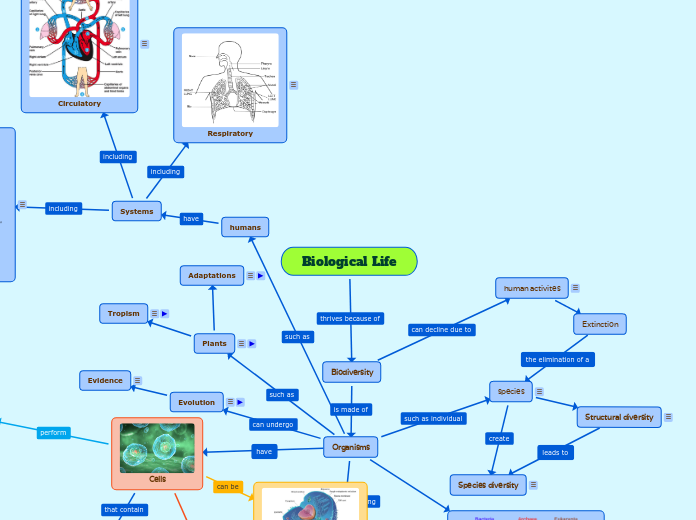Biological Life
Biodiversity
Organisms
Taxonomy
The science of identifying and classifying all organisms. Named after Carl Linnaeus who formalized this system.Organisms are classified using dichotomous keys and binomial nomenclature.Taxa = arrangement, nomos = lawIn order from least specific to most specific, the taxa (ranks) are:DomainKingdomPhylumClassOrderFamilyGenusSpeciesHumans can be classified this way:EukaryaAnimaliaChordataMammaliaPrimatesHominidaeHomosapiens
Binomial nomenclature
Format: Genus speciesLanguage: Latin (and sometimes Greek)
Protista
species
A population of individuals that are able to breed freely under natural conditions and produce viable offspring
Species diversity
The quantity of species present.More species + more individuals from those species = more diversityDiversity of interactions and interdependence (ex: food supply, protection, transportation, reproduction, hygiene, digestion)Genetic diversity (greater gene pool)
Structural diversity
The range of physical shapes and sizes within a habitat or ecosystemCreates microhabitats (even more diversity) and more resilient ecosystems

Phylogenic Tree
The study of evolutionary relationships between and among species.Scientists can compare living species with extinct organisms through phylogenetic analysis.Root = ancestral lineageTips of branches = descendantsTherefore root --> tips = moving forward in timeWe also talk about LUCA, last universial common/cellular ancestor (not the first living organism but the farthest we can trace back to).

clades
A clade is a grouping that includes a common ancestor and all living/extinct descendants of that ancestor.
Evolution
Any change in the heritable traits within a population across generations is considered evolution.
Evidence
Fossil record - less than 1% of the species in the fossil record are alive today, meaning organisms alive today are very different (meaning much time has passed) than organisms that lived long ago = evolution occurredAnatomy - evolutionary theory predicts that related organisms will share similarities that are derived from common ancestors: similar characteristics due to relatednesses are known as homologies (divergent evolution); when there are similar functions and external form for a characteristic but the internal structure and development is different, these are called analogies (convergent evolution); vestigial features are non-functional or mostly non-functional structures that are homologous to functional structures in closely related species; similarities between embryos of groups of organisms provide evidence of relatedness and evolutionBiography - similar species may live far apart in the worldArtificial selection - we have shown that we can have large effects in organisms through selective breeding for desired traits (ie. plants, dog breeds, etc)Genetic evidence - recent genetic information shows that there is evidence of evolution
humans
Systems
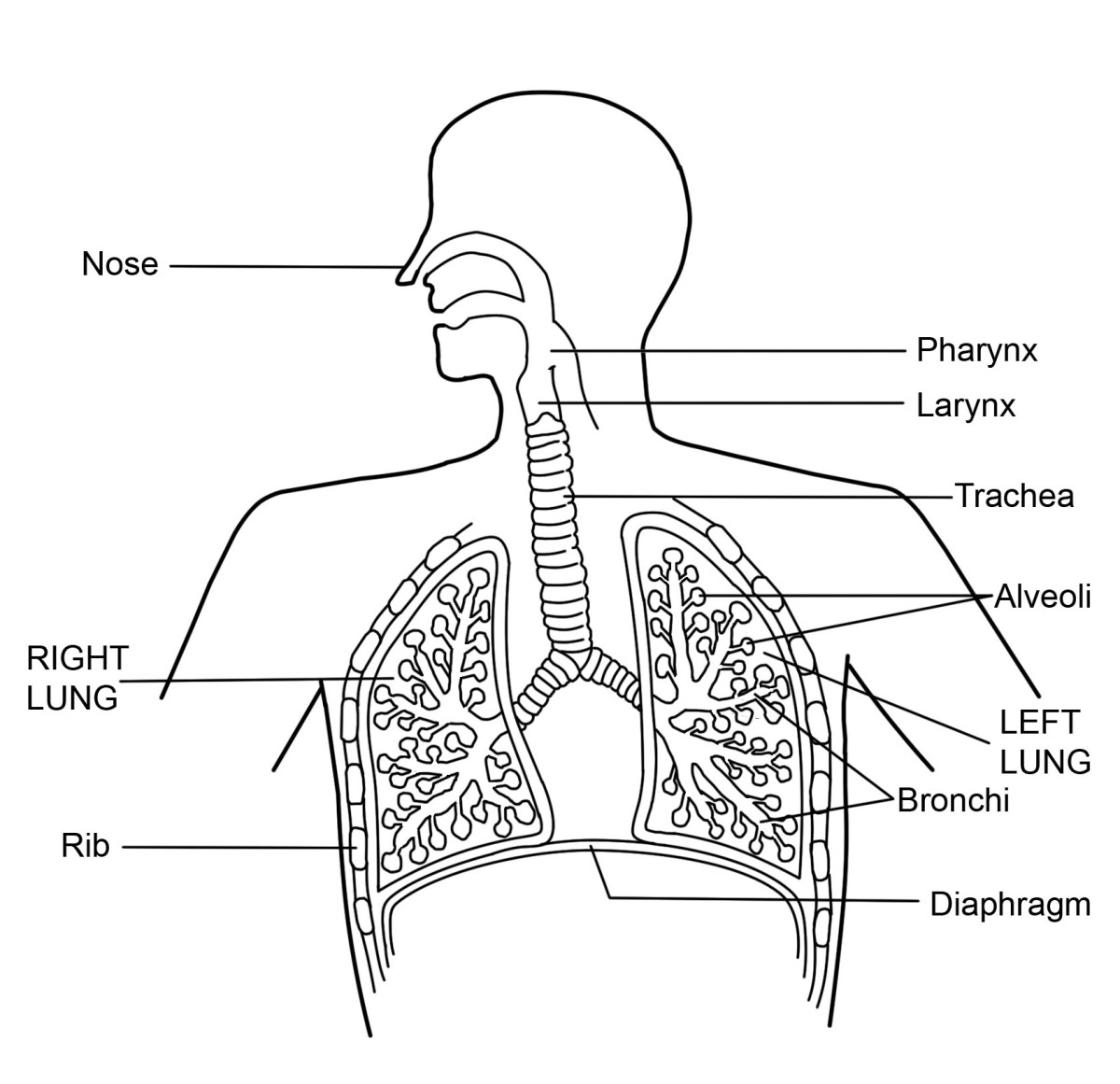
Respiratory
Nasal cavity - where hairs and mucus trap large inhaled particlesPharynx - aka the throat, it serves both the respiratory and digestive systems by receiving air from the nasal cavity, and air, food and water from the oral cavityLarynx - acts as a passageway for air between the pharynx above and the trachea belowTrachea - aka windpipe, lined with mucus-producing cells which traps airborne particles and microorganismsBronchi - they branch off of the trachea and carry air directly into the left and right lungsBronchioles - smaller airways than the bronchi, they terminate in grape-like clusters known as alveoliAlveoli - surrounded by a network of thin-walled capillaries, and they perform gas exchange by diffusion, which takes place between the capillaries and a vile alveoli walls (specifically O2 and CO2)
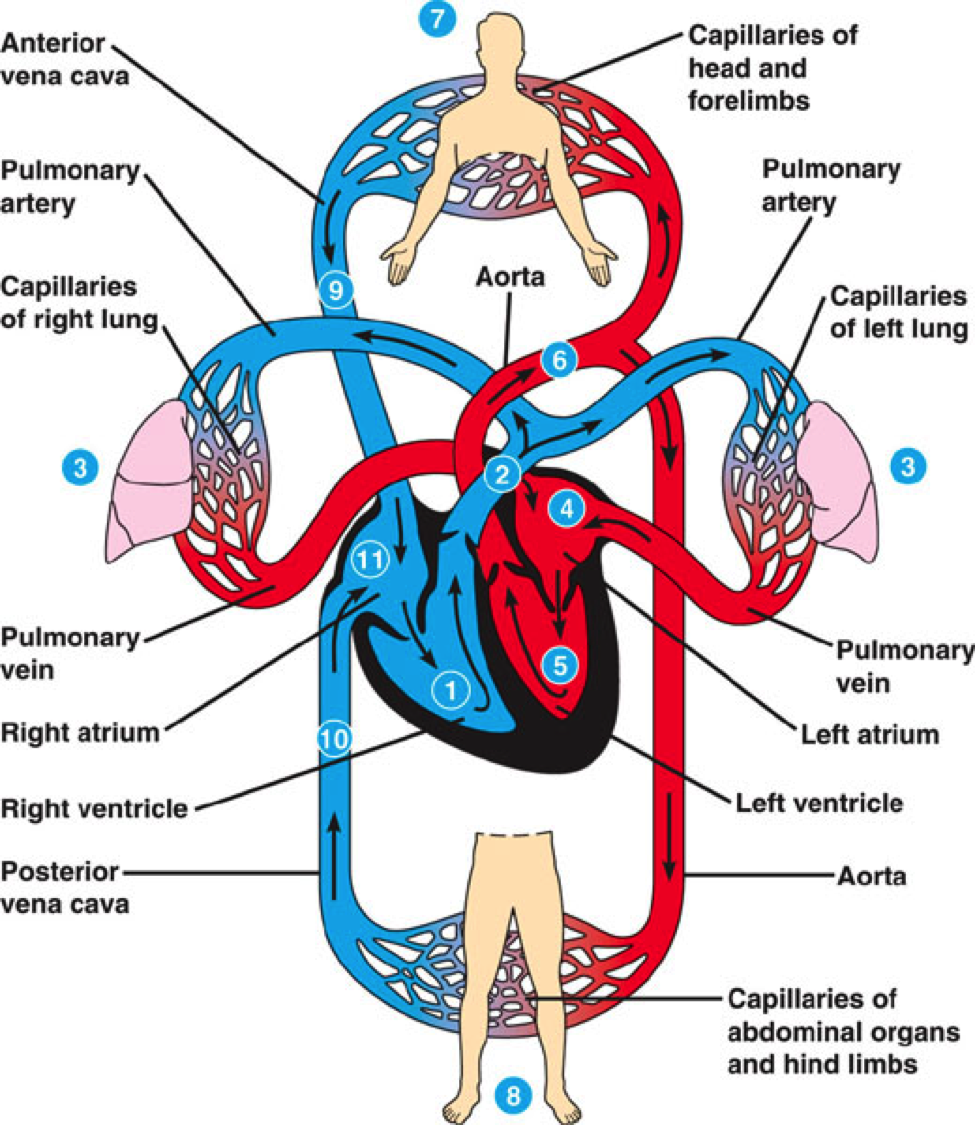
Circulatory
Blood - delivers oxygen, nutrients and hormones to cellsBlood vesselsArteries - carries blood away from the heartVeins - carries blood towards the heartCapillaries - site of gas exchange with tissue cells

Digestive
Mouth - teeth chew food, tongue positions and taste foodPharynx - passageway for food and air, participates in swallowingEsophagus - moves food from the pharynx to the stomachStomach - stores and mixes food, begins chemical digestion of protein by enzymes and acid, regulates delivery to the small intestineLarge Intestine - absorbs nutrients, stores waste materialSmall Intestine - digest proteins, fats and carbohydrates, absorbs most of the nutrients, secretes digestive hormones and enzymesRectum - passageway for fecesAnus - expels undigested materialSalivary glands - saliva moistens food, amylase digests starchLiver - produces bile, performs various functions associated with processing and storing nutrientsGall bladder - stores and concentrates bilePancreas - secretes digestive enzymes into small intestine
Macromolecules
Carbohydrates: glucose monomer; the primary source of energy & structure for chitin and celluloseProteins: amino acids monomers; structural support of hair and nails, controls the movement of material going in/out of cellsLipids: hydrocarbon monomers; long-term energy storage & main structural components of cell membranesNucleic acid: polymer of similar monomers called nucleotides; composite molecules made up of sugar, phosphate and nitrogenous base
Plants
StructureRoots - absorbs water and nutrients, serves as a reservoir of leftover food, keeps the plant anchored in the groundStems - contain structures that transport fluids, stores nutrients, support function, home to meristems cellsLeaves - primary function: photosynthesis in order to exchange gases with the atmosphere, absorbs sunlightTissue FunctionsDermal - make up the outermost layer and help prevent damage and water lossVascular - transportation of material throughout the plant: xylem carries water and dissolved minerals, from the roots to the leaves; phloem carries up glucose made from photosynthesis combined with water from the leaves throughout the plantGround - storage, support, and metabolismMeristematic - producing new cells
Tropism
Tropism is a plant's response to an environmental stimulus. It can cause a plant to grow toward or away from a stimulus. (short-term response)
Adaptations
Adaptations are inherited features or characteristics that help an organism survive and reproduce in its environment. (long-term response)
human activites
Such as:habitat destructionair/water pollutionover exploitationurban expansionclimate change
Extinction

Cells
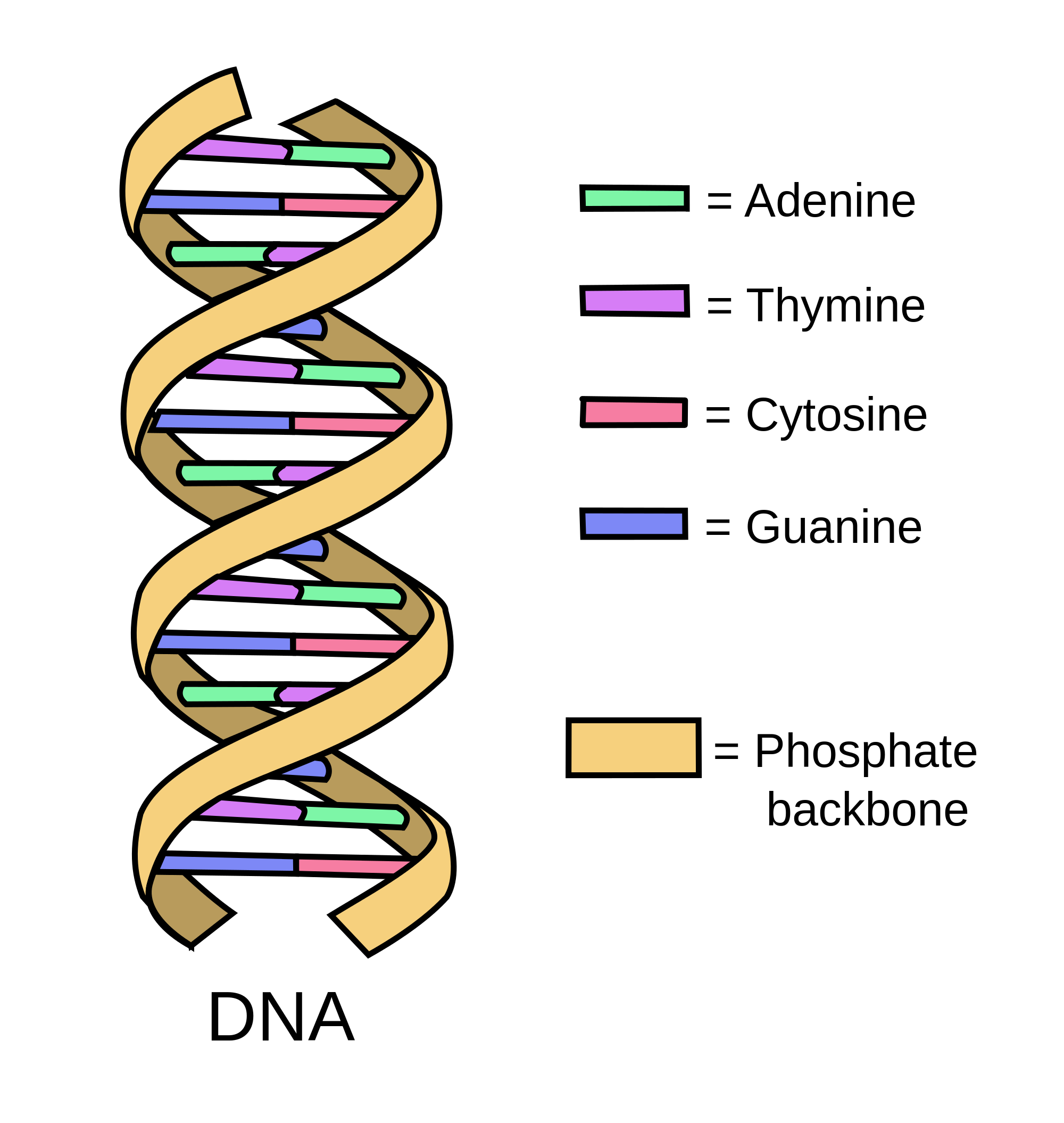
DNA
DNA is made up of deoxyribose sugar, phosphates and nucleotides, aka nitrogenous bases (made of adenine, thymine, guanine and cytosine).Adenine pairs with Thymine (AT)Guanine pairs with Cytosine (GC)
genes
The unit of heredity, a section of DNA sequence that codes for a single protein.
alleles
Dominant: allele of a gene that hides or suppresses the expression of another allele, in heterozygous casesRecessive: an allele that is hidden by a dominant allele; does not show in heterozygous condition, only in homozygousHomozygous - having identical genes (one from each parent)Heterozygous - having two different genes for a particular characteristicTrue-breeding/purebred: homozygous for a trait Hybrids: heterozygous for a trait
two genes
same position
homologous chromosomes
trait
Term that describes the variant of the allele
genotypes
The genetic makeup of an organism's allelesAn example of co-dominance is the ABO system of human blood types, which involves three alleles: IA, IB (co-dominant) and i (recessive).This makes four possible phenotypes (aka blood types) possible: A, B, AB and O.
phenotypes
Physical appearance as a result of genotypes

Punnett Squares
Punnett Square - a tool used to predict possible genotypic and phenotypic ratios of offspring of two individuals (when the genotype of the parental generation is known)P generation - parental generationF1 generation - first filial generation (offspring of P)F2 generation - second filial generation (offspring of F1)
Monohybrid crosses
Genetic cross involving a single pair of genes (one trait)
sex-linked
genome
The entire set of genes within an organism

Prokaryotic
tiny & simpleno true nucleusno organelles(most) have a cell wallcan be autotrophic or heterotrophicEubacteria (such as Streptococcus and E-coli) and Archaebacteria (thermophiles, acidophiles, and methanogens) are prokaryotic.Size: 1-5μm in diameterThe collective mass of prokaryotes is 10x more than that of eukaryotes.Thrive in environments that are too hot, cold, salty, acidic, alkaline for any eukaryote: in a nutshell, they love extreme environments.Not all prokaryotes (such as bacteria) are harmful: most bacteria are benign or beneficial.
Bacteria
Structure
Asexually
sucessful
Kingdoms

Eukaryotic
large & complexhas a nucleusnumerous organellesHave cell wallAutotrophs: Plantae (moss and ferns)Heterotrophs: Fungi (yeast, mold, and mushrooms)No cell wallMulticellular and Heterotrophs: Animalia (insects, birds, fish and humans)Unicellular and Autotrophs & Heterotrophs: Protista (protozoa, algae and slime moulds)Size: 10-100 μm in diameter
Cell divisions

Mitosis
MitosisProphase -Metaphase -Anaphase -Telophase -
somatic cell
Somatic cells are any cells in the body that are not sperm or egg cells.
diploid cell
Di - twoploid - sets of chromosomes
one cell division
two diploid cells
same
chromosomes
parent cell
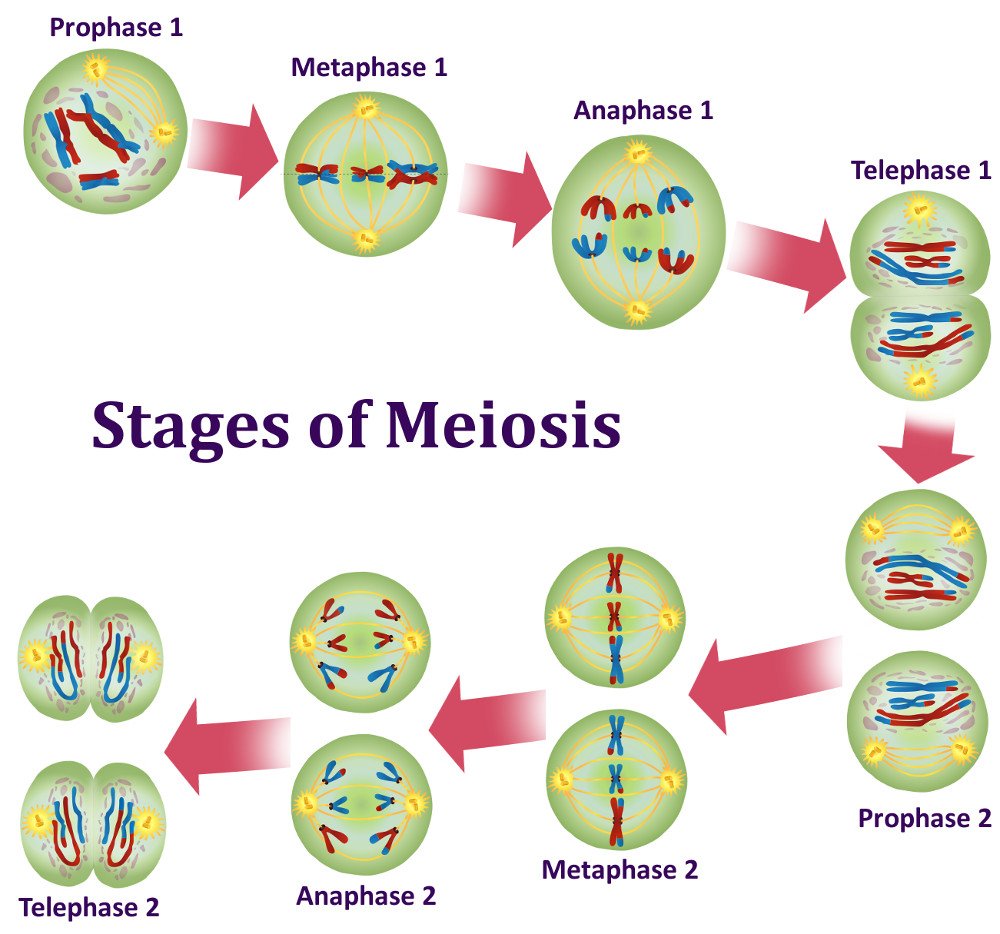
Meiosis
Meiosis IInterphase - DNA doublesProphase I - chromatids condense to become smaller and make it easier to move; form tetrad structure (four chromatids) and perform crossing-over (exchange of genetic material); centrosomes move to opposite poles of the cell and send out spindles fibres that attach to the chromosomes, the membrane of the nucleus breaks downMetaphase I - mitotic spindle fibres line up the tetrads in the middle of the cell, independent assortment occurs (alleles of two or more different genes get sorted into gametes independently of one another)Anaphase I - tetrads are separated and homologous chromosomes are guided to opposite poles of the cellTelophase I - cleavage furrow (in animal cells) forms in the middle of the cell; cytokinesis (Cyto - cytoplasm, kinesis - movement) separates cell's cytoplasm to make two unique daughter cellsMeiosis II (similar to Meiosis I)Prophase II - same as Prophase I, no interphase and crossing overMetaphase II - sister chromatids attach to the spindle and line up at the middle of the cellAnaphase II - sister chromatids separateTelophase II - same as Telophase I, but chromosomes become uncondensed (become longer again); results in 4 haploid cells
germ cell
Germ cells are the cells that undergo meiosis to produce gametes like sperm and egg cells.Gametes are sex cells only used for reproduction.
diploid cell
Hap - oneploid - set of chromosomes
two cell divisions
four haploid cells
half
chromosomes
parent cell
Errors

Non-disjunction disorders
Homologous chromosomes/sister chromatids don't separate during meiosis (Anaphase I/II)This results in cells that either have too many (trisomy, meaning three) or too few gametes (monosomy, meaning one).

Turner's Syndrome
Missing Y chromosomePeople with Turner Syndrome will not mature sexually at puberty, be sterile, and have short stature. They may also have a broad neck and chest.

Klinefelter's Syndrome
Two X and one Y chromosome (XXY)A person will exhibit feminine body characteristics and people with Klinefelter syndrome are usually sterile.

Down Syndrome
Commonly known as trisomy 21This makes a person prone to heart defects, respiratory problems and leukemia. Common phenotypes include short stature, stubby fingers and toes, and a large tongue, making speech difficult.
